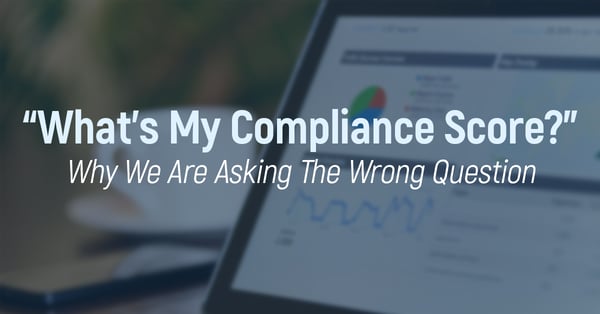
When I’m preparing to deliver a Risk Assessment Report, the first question clients often ask is, “What’s our compliance score?” While the intention is good, we are asking the wrong question. Numbers may not lie, but they don’t tell the whole truth, particularly in compliance – and in the gap is where good companies get into trouble.
When I left US Customs many, many, years ago, when it was still called US Customs, we were deep in the era of Compliance Measurement. Who remembers “Stratified Exams”? “Focus Industries”? “Office of Strategic Trade”? The “Sony Walkman”? Just me? It was the mid-90's, and after decades of criticism for their inability to gauge levels of compliance among importers, Customs embarked on a noble effort to quantify compliance. Because everyone feels better when we have numbers to tell us how well we are doing, where to focus our attention, and when to pat ourselves on the back, right?
Customs had no shortage of data to sift through, and thousands of containers to play with. In 1995, they came up with numbers - like an overall compliance rate of 80%, with higher rates of compliance where it counts (revenue collection) and lower rates of compliance where it also counts (trade statistics). How did they get to these numbers? No one outside the Service really knows, and I dare say not many inside the Service knew at the time, but I’m sure it involved statistical samplings and lots and lots of paper.
Focusing Compliance Efforts
What became clear to many was that even Customs could not measure every aspect of compliance. Tariff classification (Is the HTS# right or wrong?), quantity discrepancies (Does the number of boxes we just unloaded from this container match what’s on the invoices/packing lists?), origin marking violations (Are these items marked properly or not?) are fairly easy to verify and quantify. However, we did not see numbers on more subtle – yet potentially far more impactful – compliance issues such as failing to declare assists, improper related-party pricing, pre-payments not included on commercial invoices, and other value-related issues not apparent from either the paperwork or contents of containers.
Don’t get me wrong: It’s great to quantify compliance where you can, and these compliance measurement numbers gave Customs useful insight to key areas and enabled them to focus on certain industries where classification and other irregularities were problematic. Importers with high compliance scores in these areas were spared the scrutiny those with lower scores suffered. To this day, each company should measure compliance where it can, as well.
However, Customs also understood the limits of compliance measurement. It was no secret back then that Customs struggled to identify compliance failures outside the box, i.e., container, because they lacked business and/or industry acumen. To be fair, again, this was the 90's. Business finance was evolving rapidly, and new industries emerged almost daily. The ports were overwhelmed and couldn’t be experts on everything coming at them. Even importers were complaining that Customs couldn’t understand their challenges if Customs didn’t understand their businesses.
Developing Compliance Excellence Centers
Enter the Centers of Excellence and Expertise (CEE), Custom's organizations created to develop experts in key industries in order to facilitate trade and compliance. Customs officers learned the history and culture of their respective businesses, and they were trained on how to spot irregularities in declaration paperwork, product classifications, and countries of origin, as well as understand typical value transaction structures within their industries.
Today there are ten CEEs:
- Agriculture & Prepared Products
- Apparel, Footwear & Textiles
- Automotive & Aerospace
- Base Metals
- Consumer Products & Mass Merchandising
- Electronics
- Industrial & Manufacturing Materials
- Machinery
- Petroleum, Natural Gas & Minerals
- Pharmaceuticals, Health & Chemicals
By this time, I was well entrenched in the private sector and skeptical of these so-called Centers of Excellence and Expertise, but I have to say I was impressed with how well these folks understood my industry. They knew how we did things, they knew where we did things, and they knew what questions to ask.
Uh-Oh.
They weren’t asking about my compliance score. They were asking, “How are you managing the risks associated with sourcing your widgets from this part of Southeast Asia, because we are seeing a lot of troubling activity over there, and we’re pretty sure you are using molds like everyone else in your industry to make this product, so where are your assist declarations, and aren’t you related to so-and-so, so where is your transfer pricing study?"
See, they were less concerned with my compliance score, and far more interested in how I managed risk – risk they knew well about. For some companies, this could spell big trouble. My companies, however, knew how to manage risk. After all, that was why they hired me. I knew what was more important than a compliance score – a compliance program.
A Risk Management Game-Plan
After all these years, one thing hasn’t changed: Customs wants to know who they should be focusing on. They no longer rely solely on compliance scores. They rely on partnership programs like ISA (Importer Self-Assessment) and the upcoming CTPAT Trusted Trader Program, in which importers demonstrate their control over compliance – not through a score, but through a comprehensive, well-documented program that includes, at the very least, a Risk Assessment, SOP's, and a Compliance Manual.
Customs accepts that errors happen. Customs does not accept failure to exercise reasonable care – which is not optional but required by law. Customs expects companies to demonstrate due diligence in developing a culture of compliance.
So when clients ask me for their compliance score, I tell them we can measure only certain factors, such as classification errors or documentation deficiencies, etc. I tell them what’s most important is going over this list of risks we’ve identified, the recommendations we’ve made to manage these risks, and the implementation timeline. Then, I remind them that the most important factor to measure is your company’s commitment to import compliance, and only one number is acceptable: 100%.



